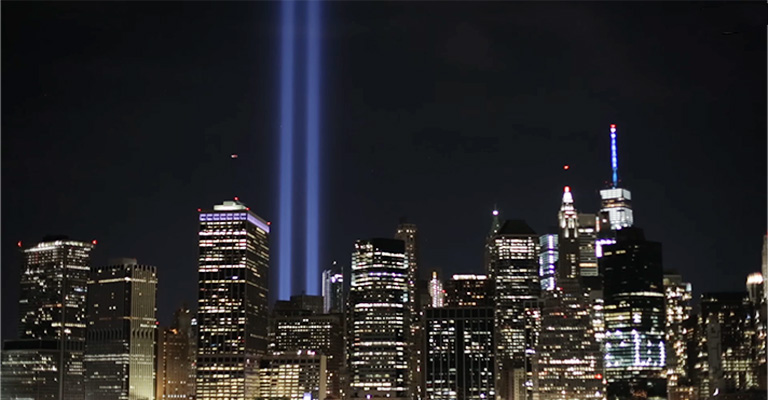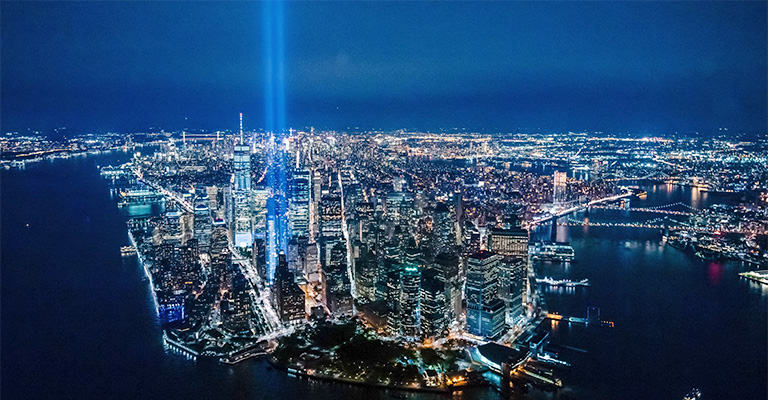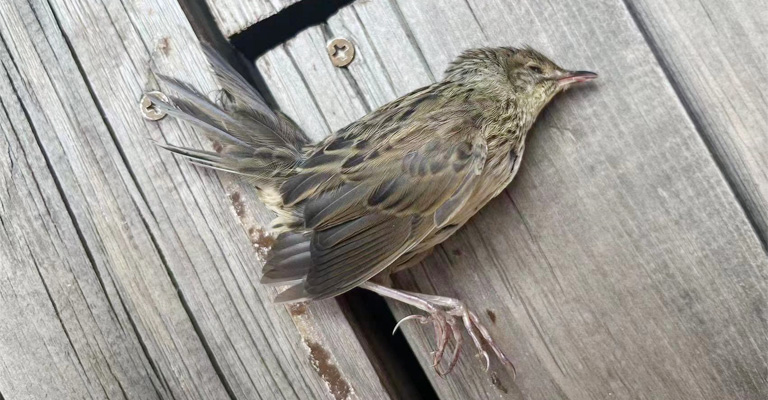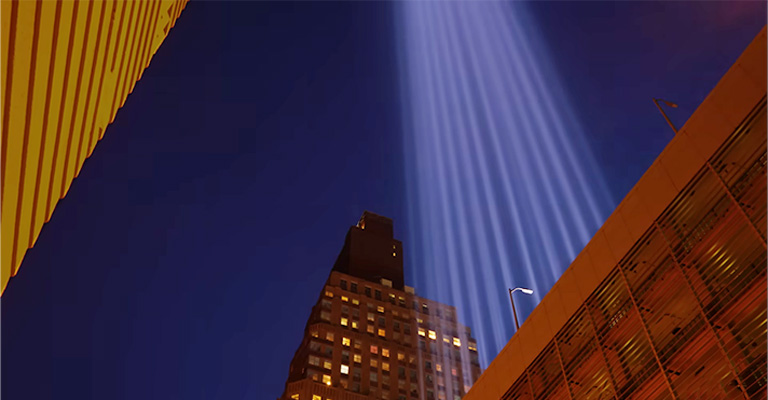The annual display of the 9/11 Memorial Lights, known as the “Tribute in Light,” is a poignant and solemn event that honors the victims of the September 11, 2001 terrorist attacks. The beams of light, reaching skyward from Lower Manhattan, symbolize resilience and unity in the face of adversity.
However, there’s a lesser-known aspect to this commemoration—the consideration for our feathered friends during their migratory journeys.
In this blog post, we delve into the question of why the 9/11 Memorial Lights are dimmed or turned off temporarily during the display.
It’s a decision rooted in compassion for the avian populations passing through the area, as these powerful beams of light can disrupt their migratory cues and pose risks to their safety.
We’ll explore the careful balance between remembrance and conservation, shedding light on the collaborative efforts that make this annual tribute more than just a memorial—it’s a testament to our commitment to coexist with nature.

What Is The 9/11 Memorial Lights?
The 9/11 Memorial Lights, also known as the “Tribute in Light,” is an annual art installation in New York City that commemorates the September 11, 2001 terrorist attacks on the World Trade Center.
The installation consists of two powerful beams of light that project into the night sky, creating a striking and solemn tribute to the nearly 3,000 people who lost their lives in the attacks.
Here are some key points about the 9/11 Memorial Lights:
Location
The Tribute in Light is typically set up in Lower Manhattan near the World Trade Center site, where the Twin Towers once stood. The lights are projected upward from a temporary installation close to the 9/11 Memorial.
Timing
The installation is displayed annually on the evening of September 11th and continues until the early morning hours of September 12th. This timing marks the anniversary of the 9/11 attacks.
Symbolism
The beams of light represent the Twin Towers themselves, serving as a symbolic reminder of the buildings that were destroyed during the attacks. The dual beams of light are often seen as a symbol of hope, remembrance, and resilience.
Tradition
The Tribute in Light was first presented in March 2002, six months after the attacks, and has been displayed annually since then, with few exceptions. It has become an important and iconic part of the 9/11 memorial ceremonies.
Installation
The beams are created by 88 powerful xenon light bulbs, arranged in two 48-foot squares to form the outline of the Twin Towers. The lights are projected vertically into the night sky, reaching up to four miles high.
Organizers
The Tribute in Light is organized by the National September 11 Memorial & Museum in collaboration with other organizations, and it involves a team of lighting designers, technicians, and volunteers.
Controversy
Over the years, the installation has faced some controversy and debate, particularly regarding its potential impact on bird migration patterns.
Measures have been taken to mitigate this impact, including monitoring and dimming the lights when necessary.
The 9/11 Memorial Lights are a solemn and powerful tribute that allows people to remember and reflect on the tragic events of September 11, 2001, and to honor the lives lost on that day. It serves as a symbol of resilience and unity in the face of adversity.
Why Do They Turn The 9/11 Memorial Lights Off for Birds?

The decision to turn off the 9/11 Memorial Lights, also known as the “Tribute in Light,” for birds is made in consideration of bird migration patterns and the potential impact on the avian population.
Here are the primary reasons for turning off the lights for birds:
Bird Migration
New York City is a major migration pathway for birds, especially during the fall and spring seasons. Many bird species fly through the city as they migrate to and from their breeding and wintering grounds.
The intense beams of light from the Tribute in Light can disorient birds, causing them to circle in confusion and collide with buildings or other structures. This can lead to injuries or fatalities among the bird population.
Bird Conservation
Concern for bird conservation and wildlife protection has prompted efforts to reduce bird fatalities related to artificial lighting in urban areas.
Lights that are left on overnight can disrupt the natural behaviors of birds and contribute to their vulnerability during migration.
Ethical Considerations
Turning off the lights during bird migration is considered an ethical and responsible practice to minimize harm to these animals. It reflects a broader understanding of the importance of coexisting with urban wildlife and minimizing human-induced threats to their survival.
Lighting Guidelines
Organizations such as the National Audubon Society provide guidelines for minimizing the impact of artificial lighting on birds.
These guidelines include turning off or dimming lights during peak migration periods and using bird-friendly lighting designs that reduce light pollution.
Monitoring
Typically, the Tribute in Light organizers, in consultation with local bird experts and conservation organizations, monitor bird activity in the vicinity of the installation.
If a significant number of birds are found to be affected by the lights, the installation may be temporarily turned off or dimmed to allow the birds to continue their migration safely.
Balancing the need to commemorate the 9/11 attacks and the importance of bird conservation is a delicate task. The organizers of the Tribute in Light strive to strike a balance by minimizing the impact on birds while continuing to honor the memory of the victims of the September 11, 2001 attacks.
How Many Birds Died During 9/11?

The number of birds that died as a direct result of the September 11, 2001, terrorist attacks is not precisely documented, and it is difficult to provide an accurate estimate.
However, it’s important to note that the primary cause of bird mortality during that tragic event was not the attacks themselves but rather the response efforts, specifically the clean-up operations and the use of lighting at night.
The intense lights used for search and rescue operations at Ground Zero in the days following the attacks may have disoriented some birds, causing them to collide with buildings and other structures.
Additionally, the debris and dust created by the destruction of the Twin Towers could have had indirect impacts on bird populations in the area.
Efforts were made to minimize harm to birds during the recovery and cleanup operations, including monitoring for bird activity and taking steps to reduce light pollution at night.
However, specific data on the number of birds affected or killed during this period is not readily available.
Artificial Light Interferes With Cues Birds
Yes, artificial light can interfere with the natural cues that many birds rely on for navigation and other essential behaviors. This interference is known as light pollution, and it can have several negative impacts on birds and their ecosystems:
Disorientation
Birds, especially during their migratory journeys at night, often use the moon and stars for navigation. Artificial lights from buildings, streetlights, and other sources can confuse them, causing them to become disoriented.
Birds may circle lighted structures, collide with buildings, or even become lost, which can lead to exhaustion and increased vulnerability to predation.
Altered Migration Patterns
Light pollution can disrupt the timing and direction of bird migrations. Birds might start their journeys earlier or later than usual, which can affect their ability to find suitable breeding or wintering grounds and access to food resources.
Impaired Feeding and Reproduction
Artificial light at night can impact birds’ feeding and reproductive behaviors. For example, it can attract insects to well-lit areas, leading to changes in prey availability for insect-eating birds.
Additionally, light pollution can interfere with the timing of the dawn chorus (morning singing) and affect the mating and nesting behaviors of birds.
Habitat Fragmentation
Urban areas with extensive artificial lighting can create barriers for birds trying to move between habitats. This can lead to habitat fragmentation, isolating bird populations, and reducing genetic diversity.
Attraction to Buildings
Birds can be attracted to brightly lit buildings, especially during foggy or cloudy nights. This attraction can result in collisions with buildings, a significant cause of bird mortality in urban areas.
Efforts to mitigate light pollution include using bird-friendly lighting designs, reducing the intensity of artificial lighting during migration seasons, and implementing better urban planning to minimize the spread of light pollution.
These measures not only benefit birds but also contribute to reducing energy consumption and preserving the natural environment.
How the Decision to Turn off the 9/11 Memorial Lights for birds is made

The decision to turn off the 9/11 Memorial Lights, also known as the “Tribute in Light,” for the sake of birds is typically made through a collaborative and careful process that involves several parties, including wildlife experts, conservation organizations, and the organizers of the Tribute in Light.
Here’s an overview of how this decision is typically reached:
Monitoring Bird Activity
Leading up to the annual display of the Tribute in Light, bird experts and ornithologists monitor the area to assess the presence and behavior of migrating birds. They may use various methods, such as radar, bird counts, and visual observations, to track bird movements in the vicinity of the installation.
Consultation
The data collected during the monitoring phase are analyzed and shared with the organizers of the Tribute in Light. This collaboration allows both parties to understand the potential impact of the lights on migrating birds.
Consideration of Migration Timing
The decision to turn off the lights is often based on the timing of bird migration in the area. Lights are more likely to be dimmed or turned off during peak migration periods, which can vary depending on the species of birds and their routes.
Prioritizing Bird Safety
The primary concern is the safety and well-being of the migrating birds. If it is determined that the lights could pose a significant risk to bird populations, organizers may choose to dim or turn off the beams temporarily.
Communication with the Public
Organizers communicate their decision to the public, explaining the reasons for dimming or turning off the lights and emphasizing the importance of bird conservation.
Flexibility
The decision to dim or turn off the Tribute in Light is often made with flexibility in mind. If bird activity decreases or if weather conditions change, adjustments to the lighting can be made accordingly.
Balancing Remembrance and Conservation
Balancing the desire to honor the memory of the 9/11 attacks with the need to protect bird populations is a central consideration. The goal is to find a respectful compromise that respects both objectives.
It’s important to note that the decision-making process regarding the Tribute in Light and its impact on birds reflects a broader awareness of the importance of bird conservation and the need to mitigate human activities that can harm migratory bird populations.
This collaborative approach helps ensure that the installation can continue to serve as a meaningful memorial while minimizing its impact on the natural environment.
FAQs
The 9/11 Memorial Lights are turned off for birds to protect their safety during migration. Bright lights can disorient birds, causing collisions and exhaustion. Turning off the lights temporarily during peak migration periods helps safeguard these avian travelers.
The lights are typically dimmed or turned off during the annual display on the evening of September 11th and the early morning hours of September 12th when bird migration in the area is most active.
Decisions are made based on bird monitoring data and consultation with ornithologists. If significant bird activity is observed during migration, organizers may choose to dim or turn off the lights to protect birds from disorientation and collisions.
No, turning off the lights temporarily to protect birds doesn’t diminish the memorial’s significance. It demonstrates a commitment to balancing remembrance with environmental responsibility and respects the memory of the 9/11 victims while acknowledging the importance of bird conservation.
Yes, in addition to dimming or turning off the lights, organizers use bird-friendly lighting designs and collaborate with conservation organizations to reduce light pollution. These measures aim to strike a balance between memorializing 9/11 and protecting avian wildlife during migration.
Wrapping Up
The decision to turn off the 9/11 Memorial Lights for birds underscores the importance of harmony between our commemorations and the natural world.
As we remember the lives lost on that fateful day, we also acknowledge our responsibility to protect and respect the environment.
This act of temporarily dimming or turning off the lights during peak migration periods is a small yet powerful symbol of our commitment to both remembrance and conservation.
It serves as a reminder that even in the heart of a bustling metropolis, we can find ways to coexist with the diverse wildlife that shares our urban spaces.
In this balance, the Tribute in Light takes on even greater meaning—it becomes a tribute not just to the past but to a future where humans and nature can thrive together.